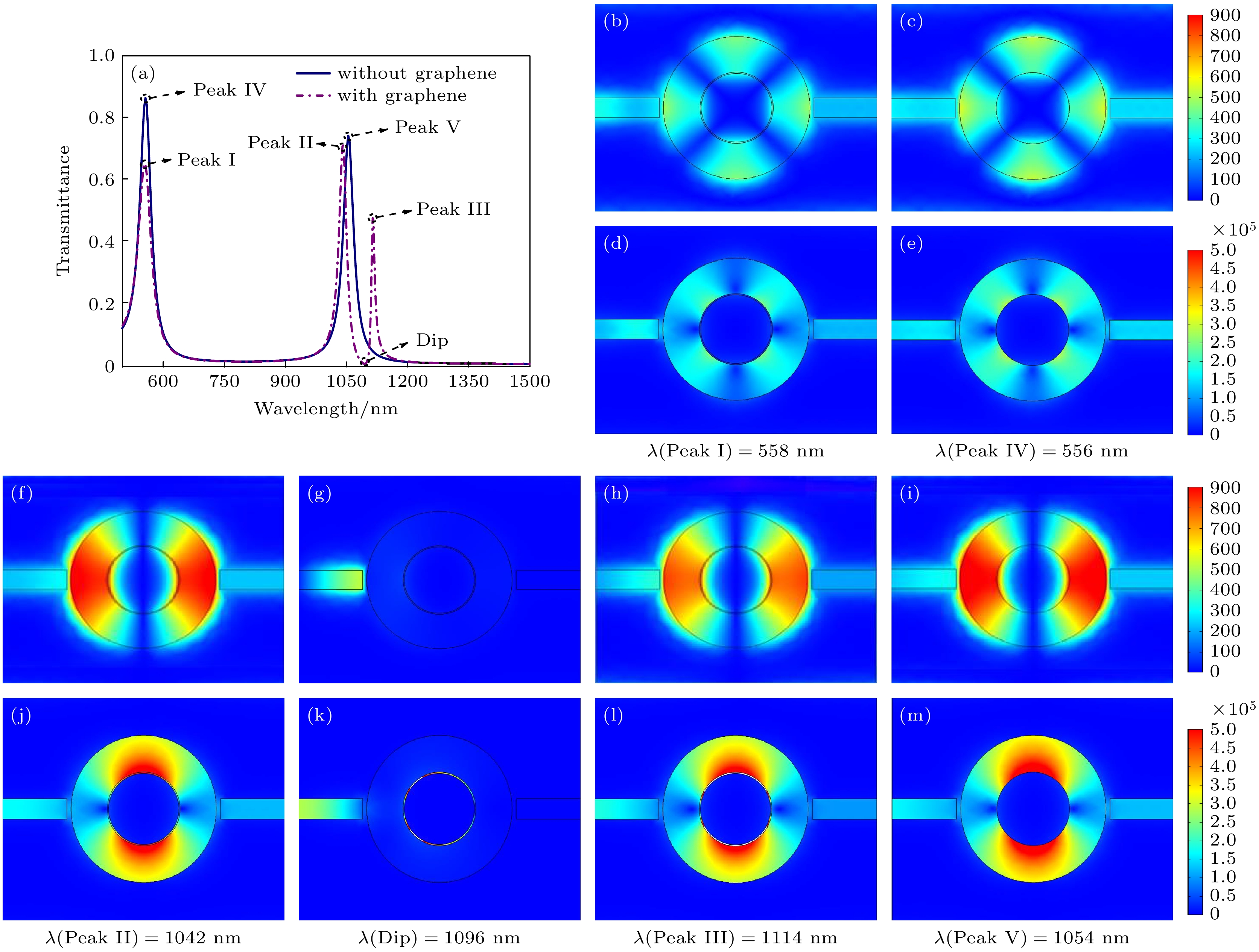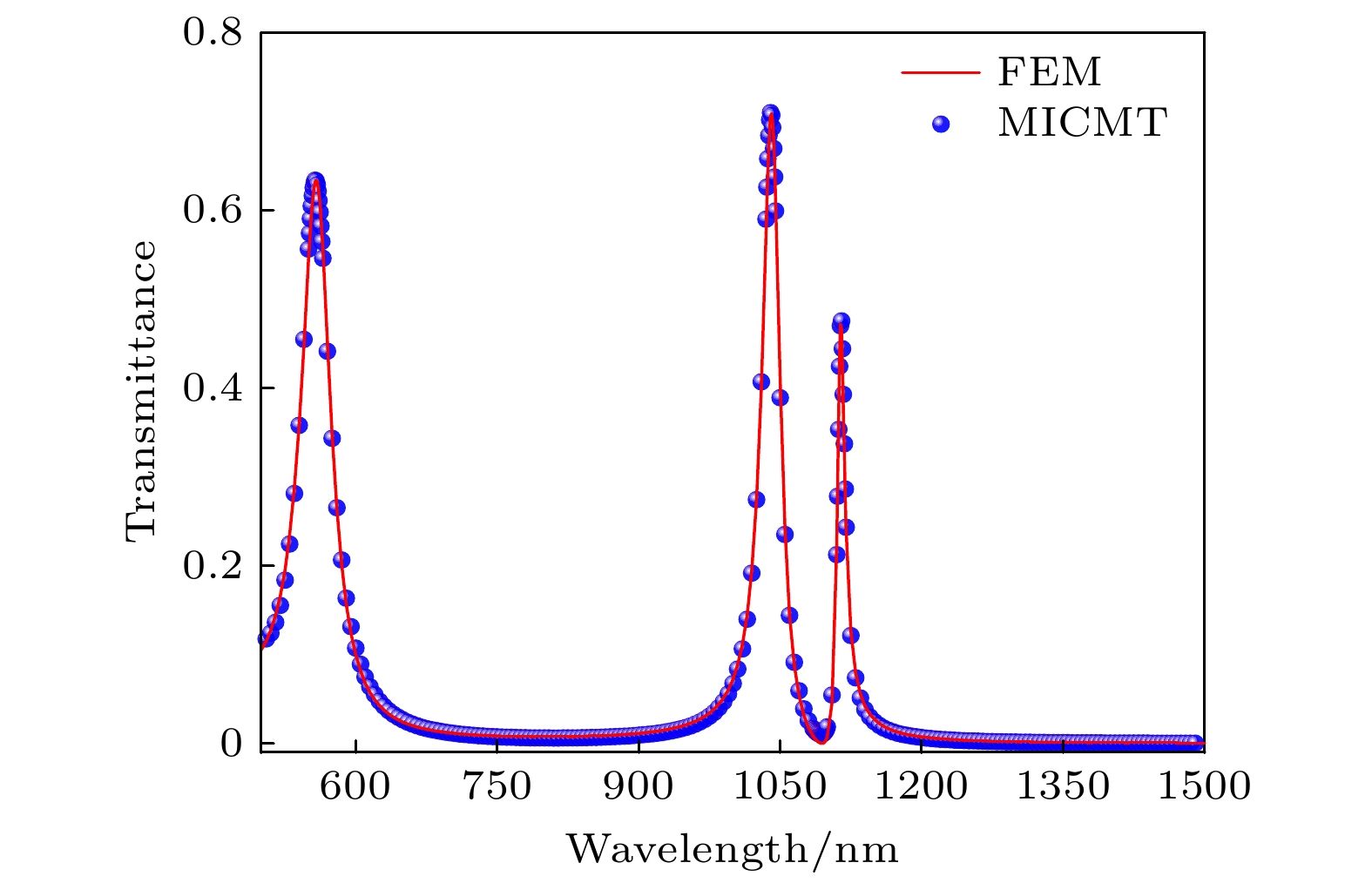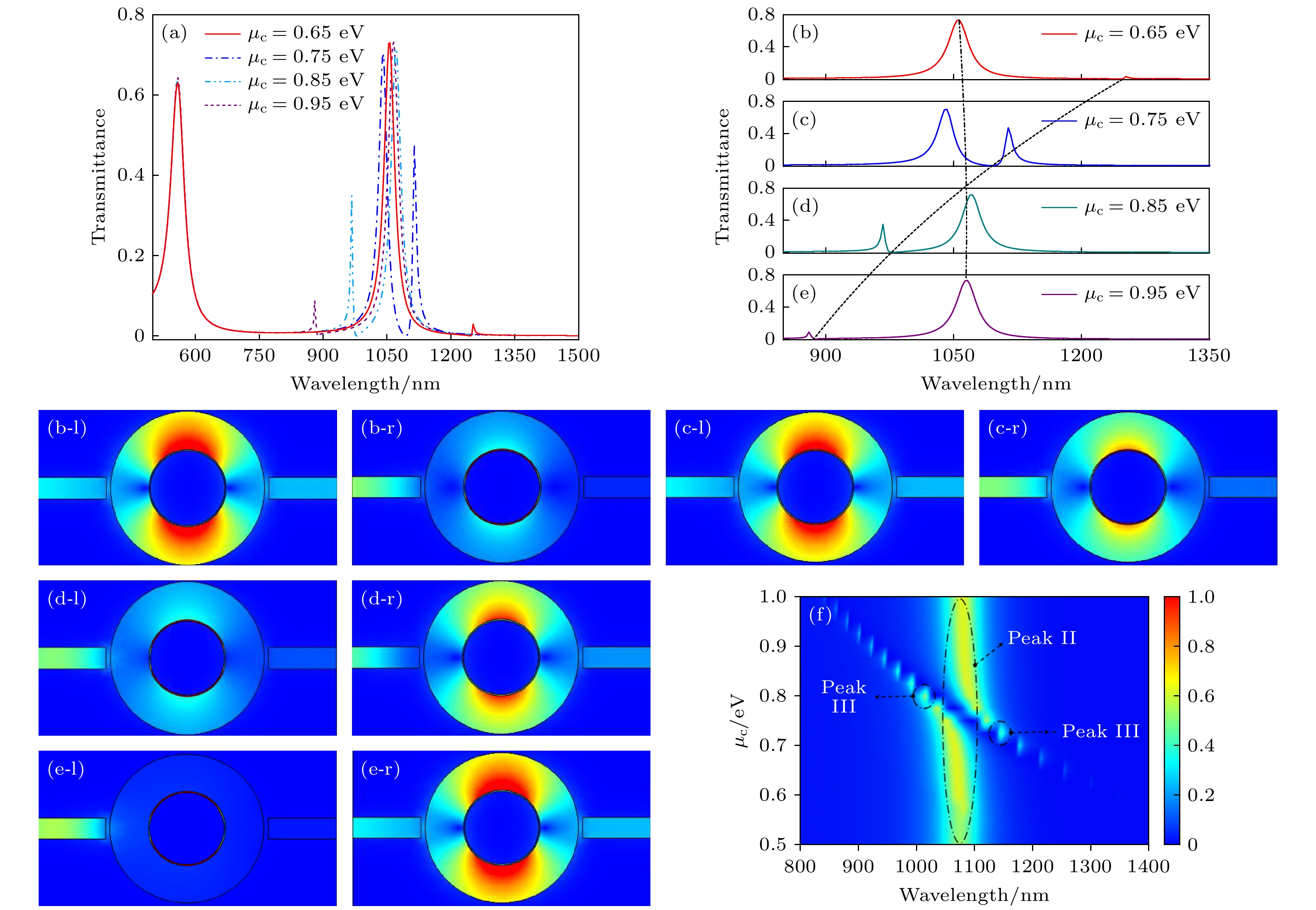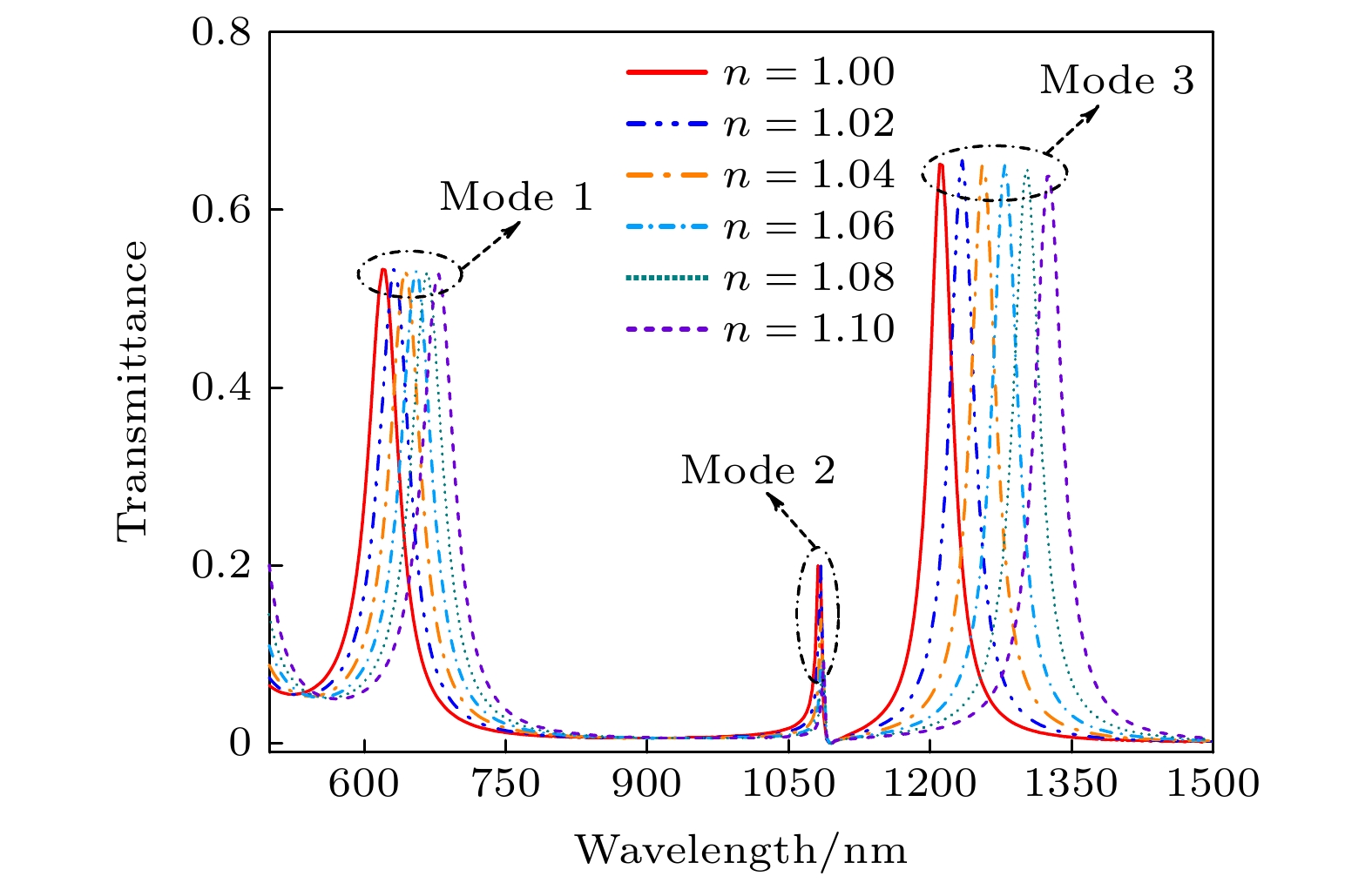-
为了解决传统金属-绝缘体-金属(metal-insulator-metal, MIM)波导结构传感器不可动态调控的问题, 本文将石墨烯纳米管引入MIM波导耦合圆环谐振腔结构, 设计了一种动态可调的MIM-石墨烯纳米管混合结构折射率传感器. 采用有限元法对系统的传输特性、电场分布和磁场分布进行数值研究, 并通过多模干涉耦合模理论进行分析验证. 结果表明, Fano共振源自于TM10腔共振模式和石墨烯等离子体电共振模式之间的相干耦合. 通过改变石墨烯的化学势可以在较大波长范围内动态调谐Fano共振的谐振波长和线宽, 从而实现折射率传感器的动态调控. 在最佳结构参数下, 传感器灵敏度可达1250 nm/RIU. 与传统的MIM波导结构相比, 该器件具有结构简单、动态可调、易于加工且工作波段范围大等诸多优点, 对设计可动态调控的高性能纳米光子集成器件具有一定的指导意义.In practical applications, the performances of conventional metal-insulator-metal (MIM) waveguide structured optical devices cured during fabrication are not dynamically tunable. In order to address the problem that such devices are not dynamically tunable, based on the excellent optoelectronic properties of graphene materials, graphene nanotubes are induced into the metal-insulator-metal waveguide coupled circular resonant cavity structure, thus designing a dynamically tunable MIM-graphene nanotube hybrid structure refractive index sensor in this work. The finite element method (FEM) is used to numerically study the transmission characteristics, electric field distribution and magnetic field distribution of the system, and the theoretical analysis is performed by multimode interference coupled mode theory (MICMT) to verify its correctness. The results show that after adding graphene nanotube to the MIM waveguide coupled ring resonant cavity structure, a Fano resonance peak appears in this system, which originates from the coherent coupling between the TM10 cavity resonance mode and the graphene plasmonic electrical resonance mode. The sensor can dynamically tune the resonance wavelength and linewidth of Fano resonance in a wide wavelength range by changing the chemical potential of graphene, thus realizing the performance tuning of the refractive index sensor. Hence, the problem that the conventional plasma refractive index sensor is not dynamically tunable issolved. In addition, the influence of the geometrical parameters of the structure on the sensing performance of this system is also studied in detail. The sensor sensitivity increases up to 1250 nm/RIU and the quality factor rises up to 42.4 RIU–1 at the optimal structural parameters. Compared with the traditional metal-insulator-metal waveguide structure design, this device has many merits such as wide operating band range, easy processing and dynamic tunability, which is a guideline for designing the dynamically tunable high performance nano-photonic integrated devices.
-
Keywords:
- surface plasmon polaritons /
- graphene nanotube /
- refractive index sensor /
- multimode interference coupled mode theory
[1] Zafar R, Salim M 2015 IEEE Sens. J. 15 11
 Google Scholar
Google Scholar
[2] Yuan M R, Lu Y C, Zhang Y, Zhang Z Y, Li Y F, Liu H C, Zhang X X, Han J G, Zhang W L 2020 Opt. Express 28 1987
 Google Scholar
Google Scholar
[3] Qi Y P, Ding J H, Zhang T, Liu W M, Wang L Y, Wang X X 2021 EPL 134 67001
 Google Scholar
Google Scholar
[4] Chen J, Nie H, Tang C J, Cui Y H, Yan B, Zhang Z Y, Kong Y R, Xu Z J, Cai P G 2019 Appl. Phys. Express 12 052015
 Google Scholar
Google Scholar
[5] Su W, Ding Y M, Luo Y L, Liu Y 2020 Results Phys. 16 102833
 Google Scholar
Google Scholar
[6] Wang M M, Zhang M, Wang Y F, Zhao R J, Yan S B 2019 Sensors 19 791
 Google Scholar
Google Scholar
[7] Chen H W, Qi Y P, Ding J H, Yuan Y J, Tian Z T, Wang X X 2022 Chin. Phys. B 31 034211
 Google Scholar
Google Scholar
[8] Limonov M F, Rybin M V, Poddubny A N, Kivshar Y S 2017 Nat. Photon. 11 543
 Google Scholar
Google Scholar
[9] Fang Y H, Wen K H, Li Z F, Wu B Y, Guo Z C 2020 Mod. Phys. Lett. B 34 16
 Google Scholar
Google Scholar
[10] Yang X Y, Hua E, Su H, Guo J, Yan S B 2020 Sensors 20 4125
 Google Scholar
Google Scholar
[11] Xie Y Y, He C, Li J C, Song T T, Zhang Z D, Mao Q R 2016 IEEE Photon. J. 8 4802512
 Google Scholar
Google Scholar
[12] Cheng Q, Wang S T, Lv J T, Liu N, Pang B 2020 Opt. Commun. 464 125393
 Google Scholar
Google Scholar
[13] Morozov Y M, Lapchuk A S, Fu M L, Kryuchyn A A, Huang H R, Le Z C 2018 Photonics Res. 6 149
 Google Scholar
Google Scholar
[14] Li S L, Zhang Y Y, Song X K, Wang Y L, Yu L 2016 Opt. Express 24 15351
 Google Scholar
Google Scholar
[15] Zhang Z D, Luo L, Xue C Y, Zhang W D, Yan S B 2016 Sensors 16 642
 Google Scholar
Google Scholar
[16] Liu Z H, Ding L Z, Yi J P, Wei Z C, Guo J P 2018 Optoelectron. Lett. 14 421
 Google Scholar
Google Scholar
[17] Xiao G L, Xu Y P, Yang H Y, Ou Z T, Chen J Y, Li H O, Liu X P, Zeng L Z, Li J Q 2021 Sensors 21 1164
 Google Scholar
Google Scholar
[18] Wang W, Meng Z, Liang R S, Chen S J, Ding L, Wang F Q, Liu H Z, Meng H Y, Wei Z C 2018 Opt. Commun. 415 130
 Google Scholar
Google Scholar
[19] Chen X, Fan W H, Song C 2018 Carbon 133 416
 Google Scholar
Google Scholar
[20] 肖功利, 杨秀华, 杨宏艳, 窦婉滢, 徐俊林, 韦清臣, 李海鸥, 张法碧, 李琦, 陈永和, 傅涛, 孙堂友 2019 光学学报 39 0728011
 Google Scholar
Google Scholar
Xiao G L, Yang X H, Yang H Y, Dou W Y, Xu J L, Wei Q C, Li H O, Zhang F B, Li Q, Chen Y H, Fu T, Sun T Y 2019 Acta Opt. Sin. 39 0728011
 Google Scholar
Google Scholar
[21] Dai X Y, Ruan B X, Xiang Y J 2021 Biosensors 11 400
 Google Scholar
Google Scholar
[22] Nair R R, Blake P, Grigorenko A N, Novoselov K S, Booth T J, Stauber T, Peres N M R, Geim A K 2008 Science 320 1308
 Google Scholar
Google Scholar
[23] García de Abajo F J 2014 ACS Photonics 1 135
 Google Scholar
Google Scholar
[24] Yan X C, Wang T, Han X, Xiao S Y, Zhu Y J, Wang Y B 2016 Plasmonics 12 1449
 Google Scholar
Google Scholar
[25] Yuan Y J, Qi Y P, Zhang B H, Ding J H, Liu W M, Chen H W, Wang X X 2022 Phys. Scr. 97 025507
 Google Scholar
Google Scholar
[26] Liu Q, Liu M W, Zhan S P, Wu L X, Xie S X, Chen Z H, Zhang Y C 2019 Plasmonics 14 1005
 Google Scholar
Google Scholar
[27] Wang P F, Ding M, Murugan G S, Bo L, Guan C Y, Semenova Y, Wu Q, Farrell G, Brambilla G 2014 Opt. Lett. 39 5208
 Google Scholar
Google Scholar
[28] 孟令俊, 王梦宇, 沈远, 杨煜, 徐文斌, 张磊, 王克逸 2020 69 014203
 Google Scholar
Google Scholar
Meng L J, Wang M Y, Shen Y, Yang Y, Xu W B, Zhang L, Wang K Y 2020 Acta Phys. Sin. 69 014203
 Google Scholar
Google Scholar
[29] 祁云平, 张婷, 郭嘉, 张宝和, 王向贤 2020 69 167301
 Google Scholar
Google Scholar
Qi Y P, Zhang T, Guo J, Zhang B H, Wang X X 2020 Acta Phys. Sin. 69 167301
 Google Scholar
Google Scholar
[30] Lu H, Zeng C, Zhang Q M, Liu X M, Hossain M M, Reineck P, Gu M 2015 Sci. Rep. 5 8443
 Google Scholar
Google Scholar
[31] Falkovsky L A 2008 J. Phys. :Conf. Ser. 129 012004
 Google Scholar
Google Scholar
[32] Kuzmenko A B, van Heumen E, Carbone F, van der Marel D 2008 Phys. Rev. Lett. 100 117401
 Google Scholar
Google Scholar
[33] Wang C L, Wang Y Q, Hu H, Liu D J, Gao D L, Gao L 2019 Opt. Express 27 35925
 Google Scholar
Google Scholar
[34] Yan X, Fu R, Cheng T L, Li S G 2021 Sensors 21 3782
 Google Scholar
Google Scholar
[35] Cen C L, Chen Z Q, Xu D Y, Jiang L Y, Chen X F, Yi Z, Wu P H, Li G F, Yi Y G 2020 Nanomaterials 10 95
 Google Scholar
Google Scholar
[36] Zhang Y J, Kuang Y Q, Zhang Z D, Tang Y, Han J Q, Wang R B, Cui J G, Hou Y L, Liu W Y 2018 Appl. Phys. A 125 13
 Google Scholar
Google Scholar
[37] Chen Y Q, Bi K X, Wang Q J, Zheng M J, Liu Q, Han Y X, Yang J B, Chang S L, Zhang G H, Duan H G 2016 ACS Nano 10 11228
 Google Scholar
Google Scholar
[38] 王文雨, 张帅国, 冯宇, 米杰 2020 天然气化工(C1化学与化工) 45 123
 Google Scholar
Google Scholar
Wang W Y, Zhang S G, Feng Y, Mi J 2020 Natural Gas Chemical Industry 45 123
 Google Scholar
Google Scholar
-
图 2 (a) 加入石墨烯纳米管结构前后的透射光谱对比; (b)—(m) 不同波长对应波峰、波谷处的磁场图(上)和电场图(下)
Fig. 2. (a) Comparison of transmission spectra with and without incorporated graphene nanotube structures; (b)–(m) magnetic field distribution (top) and electric field distribution (bottom) at the corresponding peaks and troughs at different wavelengths.
图 4 (a) 随石墨烯化学势
$ {\mu _{\text{c}}} $ 变化的透射光谱图; (b)—(e) 改变$ {\mu _{\text{c}}} $ 时仅峰II和峰III的透射光谱对比图;${\mu _{\text{c}}} = 0.65{\text{ eV}}$ , 峰II (b-l)和峰III (b-r) 的电场图;${\mu _{\text{c}}} = 0.75{\kern 1 pt} {\text{ }}{\kern 1 pt} {\text{eV}}$ , 峰II (c-l) 和峰III (c-r) 的电场图;${\mu _{\text{c}}} = 0.85{\kern 1 pt} {\kern 1 pt} {\text{ eV}}$ , 峰III (d-l) 和峰II (d-r) 的电场图;${\mu _{\text{c}}} = 0.95{\text{ }}{\kern 1 pt} {\kern 1 pt} {\text{eV}}$ , 峰III (e-l) 和峰 II (e-r) 的电场图; (f) 透射强度随入射波长及$ {\mu _{\text{c}}} $ 变化的光谱图Fig. 4. (a) Transmission spectra when changing the chemical potential of graphene; (b)–(e) comparison of transmission spectra of Peak II and Peak III only when changing the chemical potential of graphene; the electric field diagram of Peak II (b-l) and Peak III (b-r) at
${\mu _{\text{c}}} = 0.65{\text{ eV}}$ ; the electric field diagram of Peak II (c-l) and Peak III (c-r) at${\mu _{\text{c}}} = 0.75{\kern 1 pt} {\text{ }}{\kern 1 pt} {\text{eV}}$ ; the electric field diagram of Peak III (d-l) and Peak II (d-r) at${\mu _{\text{c}}} = 0.85{\kern 1 pt} {\kern 1 pt} {\text{ eV}}$ ; the electric field diagram of Peak III (e-l) and Peak II (e-r) at${\mu _{\text{c}}} = 0.95{\text{ }}{\kern 1 pt} {\kern 1 pt} {\text{eV}}$ ; (f) spectra of the transmitted intensity with the variation incident wavelength and the chemical potential of graphene.表 1 拟合参数数值
Table 1. Fitting parameter values.
$\lambda $/nm ${\tau _m}$/fs ${\tau _{m0}}$/fs ${\varphi _m}$ 558 18.05855 176.34299 –0.73564π 1041 125.52873 260.88330 0.61392π 1095 5.92270 0.19382 –0.73322π 1114 447.50227 374.44485 0.60155π -
[1] Zafar R, Salim M 2015 IEEE Sens. J. 15 11
 Google Scholar
Google Scholar
[2] Yuan M R, Lu Y C, Zhang Y, Zhang Z Y, Li Y F, Liu H C, Zhang X X, Han J G, Zhang W L 2020 Opt. Express 28 1987
 Google Scholar
Google Scholar
[3] Qi Y P, Ding J H, Zhang T, Liu W M, Wang L Y, Wang X X 2021 EPL 134 67001
 Google Scholar
Google Scholar
[4] Chen J, Nie H, Tang C J, Cui Y H, Yan B, Zhang Z Y, Kong Y R, Xu Z J, Cai P G 2019 Appl. Phys. Express 12 052015
 Google Scholar
Google Scholar
[5] Su W, Ding Y M, Luo Y L, Liu Y 2020 Results Phys. 16 102833
 Google Scholar
Google Scholar
[6] Wang M M, Zhang M, Wang Y F, Zhao R J, Yan S B 2019 Sensors 19 791
 Google Scholar
Google Scholar
[7] Chen H W, Qi Y P, Ding J H, Yuan Y J, Tian Z T, Wang X X 2022 Chin. Phys. B 31 034211
 Google Scholar
Google Scholar
[8] Limonov M F, Rybin M V, Poddubny A N, Kivshar Y S 2017 Nat. Photon. 11 543
 Google Scholar
Google Scholar
[9] Fang Y H, Wen K H, Li Z F, Wu B Y, Guo Z C 2020 Mod. Phys. Lett. B 34 16
 Google Scholar
Google Scholar
[10] Yang X Y, Hua E, Su H, Guo J, Yan S B 2020 Sensors 20 4125
 Google Scholar
Google Scholar
[11] Xie Y Y, He C, Li J C, Song T T, Zhang Z D, Mao Q R 2016 IEEE Photon. J. 8 4802512
 Google Scholar
Google Scholar
[12] Cheng Q, Wang S T, Lv J T, Liu N, Pang B 2020 Opt. Commun. 464 125393
 Google Scholar
Google Scholar
[13] Morozov Y M, Lapchuk A S, Fu M L, Kryuchyn A A, Huang H R, Le Z C 2018 Photonics Res. 6 149
 Google Scholar
Google Scholar
[14] Li S L, Zhang Y Y, Song X K, Wang Y L, Yu L 2016 Opt. Express 24 15351
 Google Scholar
Google Scholar
[15] Zhang Z D, Luo L, Xue C Y, Zhang W D, Yan S B 2016 Sensors 16 642
 Google Scholar
Google Scholar
[16] Liu Z H, Ding L Z, Yi J P, Wei Z C, Guo J P 2018 Optoelectron. Lett. 14 421
 Google Scholar
Google Scholar
[17] Xiao G L, Xu Y P, Yang H Y, Ou Z T, Chen J Y, Li H O, Liu X P, Zeng L Z, Li J Q 2021 Sensors 21 1164
 Google Scholar
Google Scholar
[18] Wang W, Meng Z, Liang R S, Chen S J, Ding L, Wang F Q, Liu H Z, Meng H Y, Wei Z C 2018 Opt. Commun. 415 130
 Google Scholar
Google Scholar
[19] Chen X, Fan W H, Song C 2018 Carbon 133 416
 Google Scholar
Google Scholar
[20] 肖功利, 杨秀华, 杨宏艳, 窦婉滢, 徐俊林, 韦清臣, 李海鸥, 张法碧, 李琦, 陈永和, 傅涛, 孙堂友 2019 光学学报 39 0728011
 Google Scholar
Google Scholar
Xiao G L, Yang X H, Yang H Y, Dou W Y, Xu J L, Wei Q C, Li H O, Zhang F B, Li Q, Chen Y H, Fu T, Sun T Y 2019 Acta Opt. Sin. 39 0728011
 Google Scholar
Google Scholar
[21] Dai X Y, Ruan B X, Xiang Y J 2021 Biosensors 11 400
 Google Scholar
Google Scholar
[22] Nair R R, Blake P, Grigorenko A N, Novoselov K S, Booth T J, Stauber T, Peres N M R, Geim A K 2008 Science 320 1308
 Google Scholar
Google Scholar
[23] García de Abajo F J 2014 ACS Photonics 1 135
 Google Scholar
Google Scholar
[24] Yan X C, Wang T, Han X, Xiao S Y, Zhu Y J, Wang Y B 2016 Plasmonics 12 1449
 Google Scholar
Google Scholar
[25] Yuan Y J, Qi Y P, Zhang B H, Ding J H, Liu W M, Chen H W, Wang X X 2022 Phys. Scr. 97 025507
 Google Scholar
Google Scholar
[26] Liu Q, Liu M W, Zhan S P, Wu L X, Xie S X, Chen Z H, Zhang Y C 2019 Plasmonics 14 1005
 Google Scholar
Google Scholar
[27] Wang P F, Ding M, Murugan G S, Bo L, Guan C Y, Semenova Y, Wu Q, Farrell G, Brambilla G 2014 Opt. Lett. 39 5208
 Google Scholar
Google Scholar
[28] 孟令俊, 王梦宇, 沈远, 杨煜, 徐文斌, 张磊, 王克逸 2020 69 014203
 Google Scholar
Google Scholar
Meng L J, Wang M Y, Shen Y, Yang Y, Xu W B, Zhang L, Wang K Y 2020 Acta Phys. Sin. 69 014203
 Google Scholar
Google Scholar
[29] 祁云平, 张婷, 郭嘉, 张宝和, 王向贤 2020 69 167301
 Google Scholar
Google Scholar
Qi Y P, Zhang T, Guo J, Zhang B H, Wang X X 2020 Acta Phys. Sin. 69 167301
 Google Scholar
Google Scholar
[30] Lu H, Zeng C, Zhang Q M, Liu X M, Hossain M M, Reineck P, Gu M 2015 Sci. Rep. 5 8443
 Google Scholar
Google Scholar
[31] Falkovsky L A 2008 J. Phys. :Conf. Ser. 129 012004
 Google Scholar
Google Scholar
[32] Kuzmenko A B, van Heumen E, Carbone F, van der Marel D 2008 Phys. Rev. Lett. 100 117401
 Google Scholar
Google Scholar
[33] Wang C L, Wang Y Q, Hu H, Liu D J, Gao D L, Gao L 2019 Opt. Express 27 35925
 Google Scholar
Google Scholar
[34] Yan X, Fu R, Cheng T L, Li S G 2021 Sensors 21 3782
 Google Scholar
Google Scholar
[35] Cen C L, Chen Z Q, Xu D Y, Jiang L Y, Chen X F, Yi Z, Wu P H, Li G F, Yi Y G 2020 Nanomaterials 10 95
 Google Scholar
Google Scholar
[36] Zhang Y J, Kuang Y Q, Zhang Z D, Tang Y, Han J Q, Wang R B, Cui J G, Hou Y L, Liu W Y 2018 Appl. Phys. A 125 13
 Google Scholar
Google Scholar
[37] Chen Y Q, Bi K X, Wang Q J, Zheng M J, Liu Q, Han Y X, Yang J B, Chang S L, Zhang G H, Duan H G 2016 ACS Nano 10 11228
 Google Scholar
Google Scholar
[38] 王文雨, 张帅国, 冯宇, 米杰 2020 天然气化工(C1化学与化工) 45 123
 Google Scholar
Google Scholar
Wang W Y, Zhang S G, Feng Y, Mi J 2020 Natural Gas Chemical Industry 45 123
 Google Scholar
Google Scholar
计量
- 文章访问数: 8680
- PDF下载量: 117
- 被引次数: 0














 下载:
下载:





















